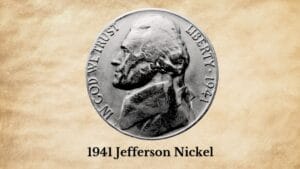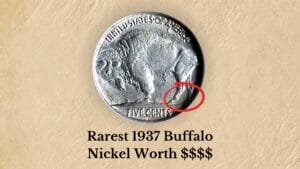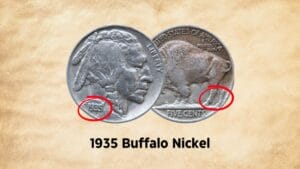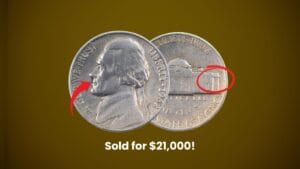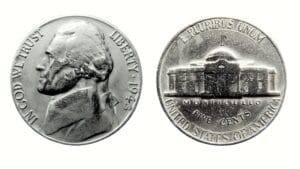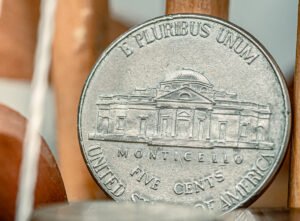Ever wondered if the old nickel in your coin jar might be worth a small fortune? You’d be surprised to know that a well-preserved 1946 Jefferson Nickel recently sold for an astonishing $9,600 at auction due to some rare error!
So if you have these old nickels, there are chances you can earn big bucks! But before that, learn what makes an old 1946 nickel valuable and how factors like condition, mint marks, and errors impact its value!
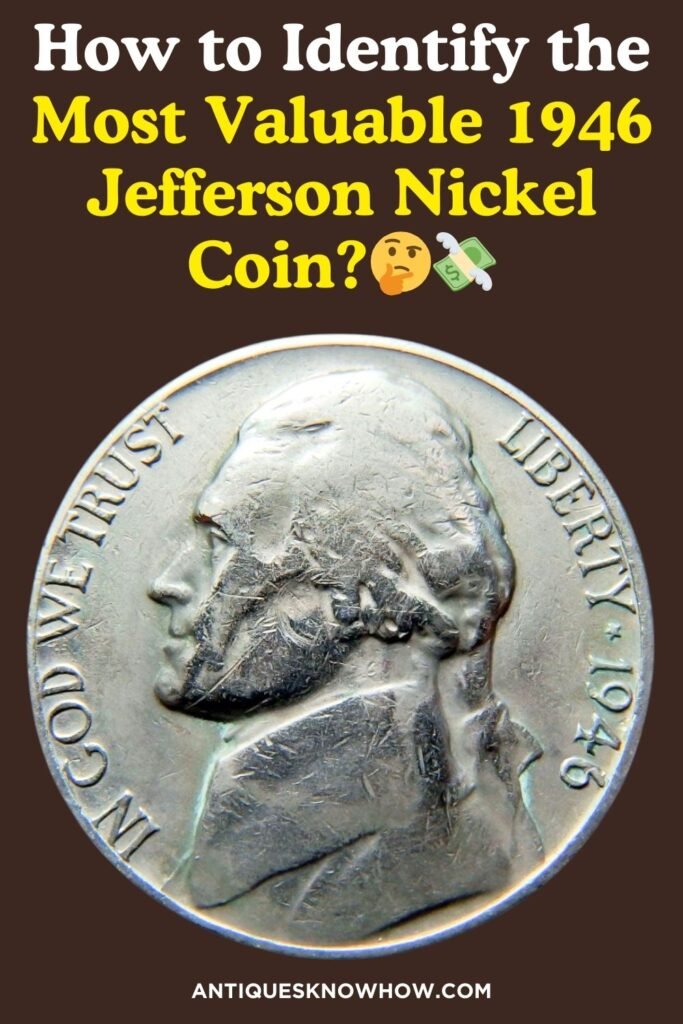
How to Spot a Real 1946 Jefferson Nickel (Design & Composition)
Identifying an authentic 1946 Jefferson Nickel needs attention to detail and knowledge of key design elements as well as other physical features, as explained below:
1946 Jefferson Nickel Obverse:
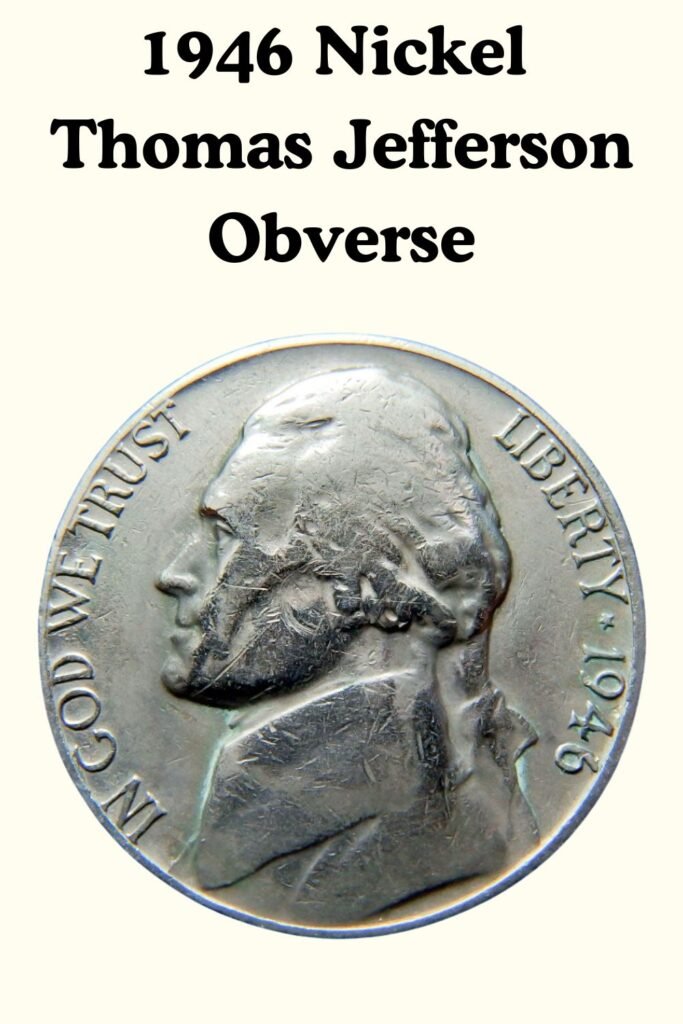
- Jefferson’s profile facing left with sharp detail
- “IN GOD WE TRUST” along the left rim
- “LIBERTY” and date “1946” on the right
- The designer’s initials “FS” appear under Jefferson’s neck
1946 Jefferson Nickel Reverse:
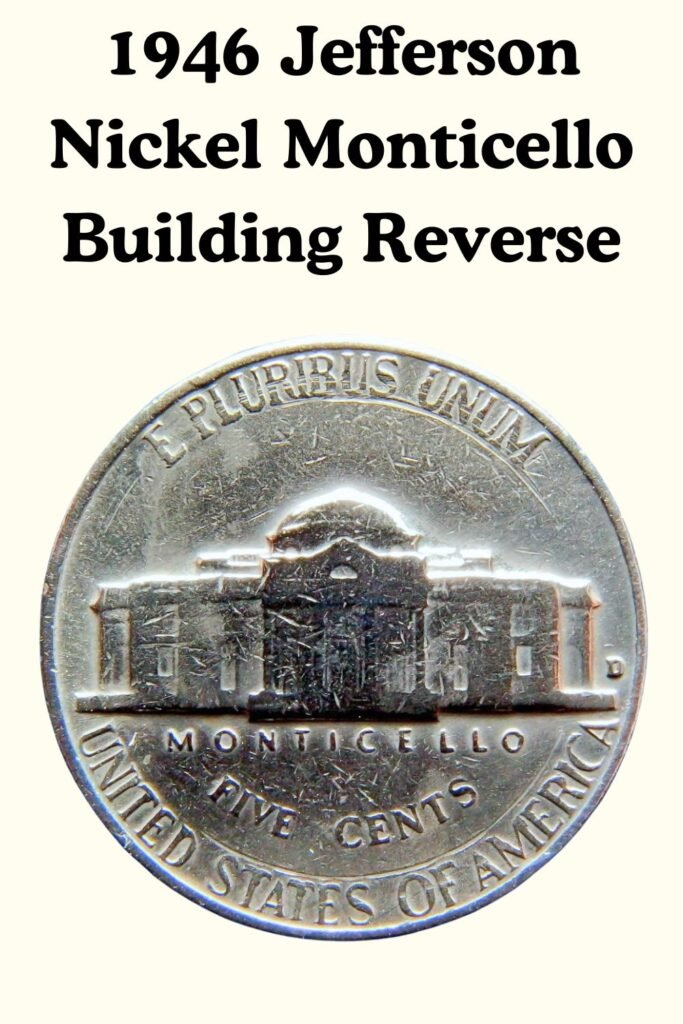
- Monticello building is shown from the front view
- The word “MONTICELLO” below building image
- “FIVE CENTS” written below Monticello
- The phrase “E PLURIBUS UNUM” on the top
- “UNITED STATES OF AMERICA” around the bottom rim
Note: Some 1946 Jefferson Nickels show clearly defined and detailed steps of Monticello. These coins are designated as a “Full Steps” variety and are more valuable than nickels with FS designation.
Coin Composition, Size, and Dimensions
The 1946 Jefferson Nickel marked the return to the standard composition of 75% copper and 25% nickel after the wartime silver alloy. The following table shows all of its features:
| 1946 Jefferson Nickel | Key Features |
| Material (Composition) | 75% Copper & 25% Nickel |
| Minting Location | Philadelphia, Denver, San Francisco |
| Minting Year | 1946 |
| Weight | 5 grams |
| Diameter | 21.2 mm |
| Thickness | 1.95 mm |
| Designer – Engraver | Felix Schlag |
| Face Value | $0.05 |
| Mint Marks | No Mint Mark – Philadelphia D – Denver mint S – San Francisco |
| Total Mintage (All Facilities) | 219,968, 200 coins |
Finding an Old 1946 Jefferson Nickel Value (4 Key Factors)
A common, circulated 1946 Jefferson Nickel generally sells for about 25 cents to $1 whereas uncirculated nickels can range from $2 to $10,000 or more, depending on factors, like condition, mint mark, Full Steps feature, and rare errors!
1. Coin Grading and Condition
The first and most important factor influencing a 1946 nickel value is its condition, graded on a professional scale from Poor (P-1) to Perfect Mint State (MS-70). Coins with higher grades are generally more valuable.
For example, most mint condition 1946 Jefferson nickels from MS65 to MS67 or above can be worth anywhere ranging from $2 to $2,000, depending on mint marks and errors.
2. Full Steps Designation
For Jefferson Nickels, the Full Steps designation is another crucial factor for valuation. Full Steps (FS) refers to the visibility of at least five complete steps on Monticello’s stairs. Rarest Six Full Steps examples can command even higher premiums, reaching up to $8,000 or more!
3. Mint Marks & Mintage of 1946 Jefferson Nickel
The total production of 1946 Jefferson Nickels reached an impressive 161,116,000 pieces across three mints: each with a unique mint mark impacting the coin’s value and rarity!
1946 No Mint Mark Nickel Value (Mintage – 161,116,000)
The Philadelphia Mint led production with over 161 million pieces without any mint mark, making it the most common mint mark variety of the 1946 Jefferson Nickel. Despite the high mintage, well-preserved 1946 No Mint mark nickels can command premiums, especially those with Full Steps.
The highest quality example known, an MS67 Full Steps, brought an astounding $8,813 Legend Rare Coin Auctions. Even in the mint state without FS designation, a 1946 no-mint mark nickel can bring $5 to $1,700!
The average values of a 2000 D Lincoln Penny in mint state are as follows:
| Coin Grades | Standard Coins | Full Step Designation |
| MS60-MS63 | $2-$5 | $10-$20 |
| MS64 | $7-$14 | $20-$40 |
| MS65-MS65+ | $12-$20 | $60-$200 |
| MS66-MS66+ | $20-$80 | $100 – $1,350+ |
| MS67 | $150-$1,700+ | $2,000-$6,600+ |
1946 D Jefferson Nickel Value (Mintage – 45,292,200)
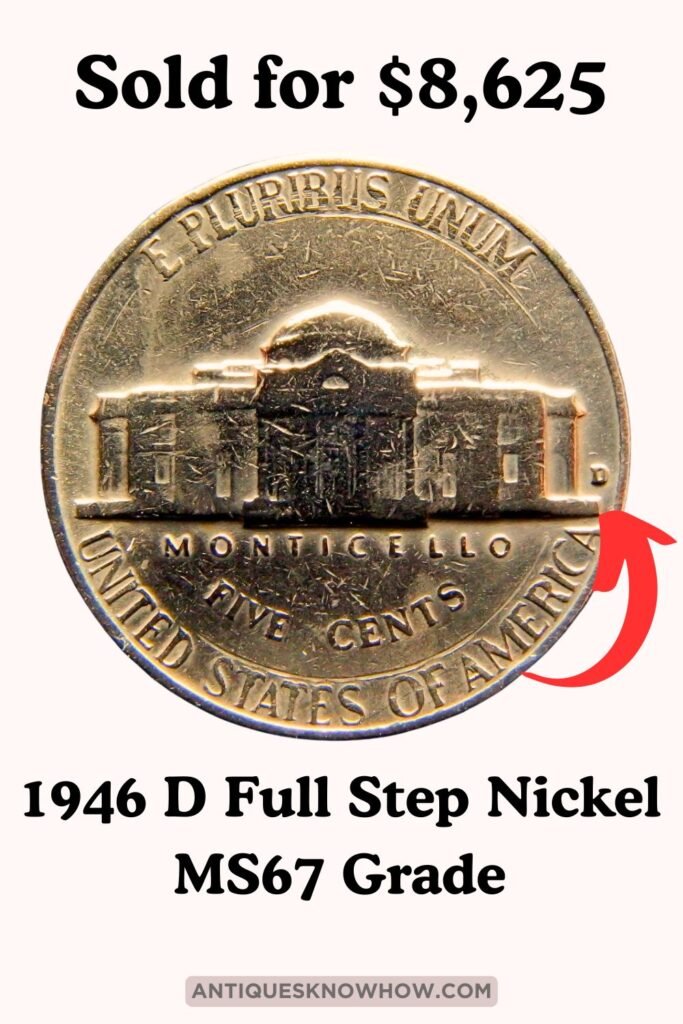
The Denver facility produced almost 45.3 million nickels in 1946 with superior strike quality and a D mint mark. These 1946 nickels are known for their well-defined steps on Monticello, making the coins with FS designation most collectible.
For example, a Full Steps 1946 D nickel can fetch $1,500 to $2,500 or more in MS67 grade, while the same grade example will only fetch $50 to $200 with the FS designation.
In an exceptional case, an MS67 FS example sold for an auction record price of $8,625 at Bowers & Merena Auctions!
| Coin Grades | 1946 D Nickel Value | 1946-D FS Nickel Value |
| MS60-MS63 | $2-$5 | $5-$10 |
| MS64-MS64+ | $5-$10 | Around $10 |
| MS65-MS65+ | $8-$12 | $15-$30 |
| MS66-MS66+ | $15-$50 | $30 – $300+ |
| MS67-MS67+ | $50-$250+ | $300-$2,500+ |
1946 S Jefferson Nickel Value (Mintage – 13,560,000)
With the lowest mintage of only 13,5 million pieces, San Francisco nickels are the scarcest of the three mints for 1946, making them most valuable across all grades.
The finest known MS67 Full Steps example reached $7,800 at Heritage Auctions, showing strong demand for high-grade 1946 S nickels.
| Coin Grades | 1946 D Nickel Value | 1946-D FS Nickel Value |
| MS60-MS63 | $2-$8 | N/A |
| MS64-MS64+ | $8-$15 | $25-$55 |
| MS65-MS65+ | $10-$20 | $30-$100 |
| MS66-MS66+ | $20-$120 | $100 – $1,200+ |
| MS67-MS67+ | $150-$800+ | $1,500-$7,800+ |
| MS68 | $850-$1,600+ | N/A |
Some of the 1946 S Jefferson nickels may also feature a sharp, reflective surface with a subtle contrast between the raised devices and fields. These special-looking coins will be designated as “Prooflike” nickels. However, no such coin has been professionally graded yet.
4. Valuable 1946 Nickel Errors
The last factor to impact a 1946 Jefferson nickel value is the minting errors. Unique errors can double or triple the value of a regular nickel. Some of the most valuable 1946 nickel errors are:
D/Inverted D FS-501
This fascinating error happened when the Denver mint mark was initially punched upside down, then corrected with a properly oriented D. You can see traces of the inverted D beneath the correct mint mark under magnification.
Mint state examples of this 1946 error coin typically bring $200-$1,000, like this MS64 FS example sold for almost $600 on eBay!
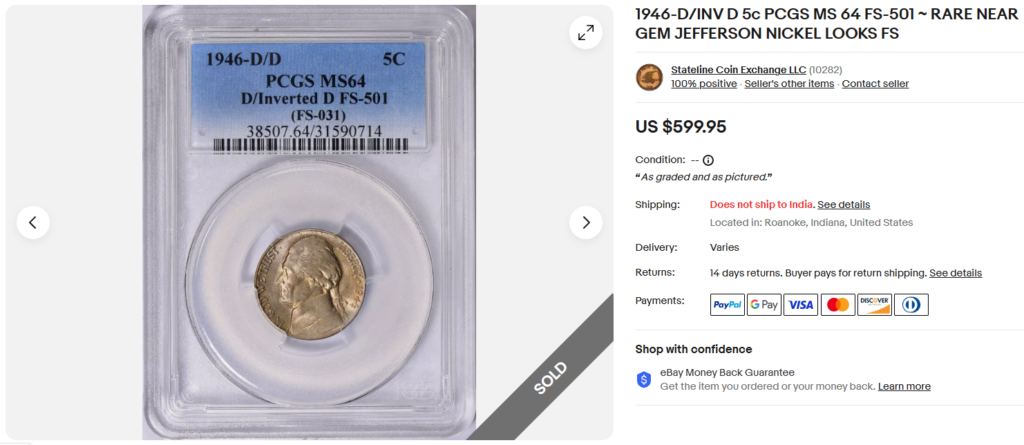
Struck on a War Nickel Planchet
When leftover wartime silver planchets from the pre-1946 era were accidentally mixed with standard planchets, they created one of the most valuable 1946 nickel errors. These coins have a distinctive silvery color and weigh about 5.6 grams instead of the standard 5.0 grams.
Since only a handful are known, this rare error coin can bring $5,000-$15,000 regardless of its condition. For example, a Fine-12 example of a 1946 nickel struck on a war planchet sold for a stunning price of $9,600 on Heritage Auctions!
Struck on a Split Planchet
This dramatic error occurs when a planchet splits horizontally before striking, resulting in a thinner-than-normal 1946 Jefferson nickel coin with rough surfaces on one side. The value of this error can range from $200-$500 for partial splits to $1,000+ for complete splits showing full designs.
Double Die Reverse (DDR)
The 1946 Double Die Reverse variety exhibits doubling most prominently in “MONTICELLO” and the steps area. Strong examples show clear separation in the building’s columns and roof details.
The value of a 1946 Jefferson nickel DDR coin can range from $250-$1,000 in mint state, even higher for coins with Full Steps designation.
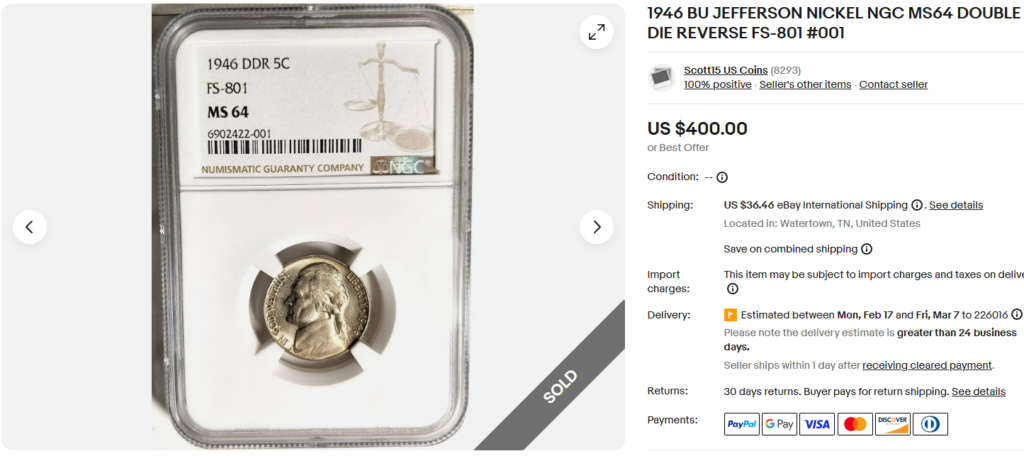
Struck on a Cent Planchet
Another dramatic error to look for! This one happens when a 1946 nickel design is struck on a copper cent planchet. These appear slightly smaller and show a distinctive copper color rather than gray.
A rare 1946 Jefferson Nickel struck on Cent planchet can reach values of $500 to $2,000 or more, depending on condition and color. An MS63 Brown 1946 Nickel on Cent planchet sold for $840 in an auction!
D over D Repunched Mint Mark
This variety shows a clear doubling of the Denver mint mark, with one D punched over another on the 1946 nickel’s reverse. The error ranges from subtle to dramatic, with values ranging from $50-$200 or more based on condition as well.
Double Die Obverse (DDO)
This 1946 nickel error shows a visible doubling in the inscriptions, particularly in the words “IN GOD WE TRUST” and “LIBERTY” on the coin obverse. This doubling occurred during the hub-to-die process when the working die received multiple, slightly misaligned impressions.
Based on the doubling strength and overall grade, a 1946 nickel with DDO error can fetch $50-$400. Full Steps examples can fetch even higher prices.
Note: This article is intended for informational, educational, and entertainment purposes only. Some images are illustrative and may not represent actual brands, products, or related entities. All trademarks, product names, brand logos, packaging, and other intellectual property referenced remain the exclusive property of their respective owners. Any brand mentions or references are provided solely for descriptive and educational context and do not imply any formal or commercial association.


